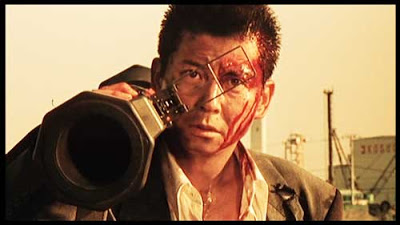Available on Blu-Ray/ DVD from Mon 27 March 2017
From infamously difficult horror to family-friendly superhero movies, Takashi Miike has never been a director that could be called ‘predictable’. So to sit down for a trilogy of Yakuza stories with the same lead actors in each separate story, one might expect Miike to employ a strong vision to act as a through-line which holds everything together. What we get instead is more of the same unpredictability that has made his such a famous name in the world of Japanese cinema.
Dead or Alive begins with an outrageous six-minute montage of sex, drugs and violence. Miike’s enfant terrible reputation breathes every stitch of the sequence to life. Driven furiously along by a muscular guitar score, the whole thing sets the audience up for one hell of an experience.
Then it dies.
Pacing issues – alongside a shocking lack of tonal consistency – plague the entire trilogy. The best and worst of everyone’s favourite controversial filmmaker are consistently on show, and it is more than a struggle to get through parts of each chapter. However, even in the absence of coherence, each movie has some element of interest to keep you watching.
Dead or Alive 2: Birds is by far the strongest of the three films, yet also the quietest. Unlike the previous entry which dealt with an all-to-familiar ‘new gang takes over the drug trade at all costs’ plot, the sequel has Riki Takeuchi & Shô Aikawa‘s hitmen (they play different people in each film) realise that they are old friends, and spends much of its run-time with them reliving their youth. It’s a crazy turn to take, interspersed with some Lynchian moments, that – where the first film looked for an instinctual response – aim for an emotional one.
The less said about the final film, Dead or Alive 3: Final the better. At times it wants to be The Matrix, others Blade Runner and occasionally flips between the styles of its two DoA predeccesors. Add to that one of the most painfully obvious exposition scenes ever committed to cinema, and you have the full recipe for the weakest of the bunch.
This new package release, complete with restored High-Definition copies of all three films, contains more than a wealth of extra-material to have cinema fans salivating. Interviews, making-of featurettes, audio commentary and more, make this release more than just a film trilogy.
Sure, they’ve all got problems and at times you’ll feel like screaming “Takashi, really!?”, but to see such an original – and overstuffed – take at what could have been three action films tossed out with guns, girls and guts makes it a worthwhile trip for fans of the director to take. There’s a fine line in art between spell-bindingly interesting and frustratingly muddled; across a total of 291 minutes, the DoA trilogy marries the two.
